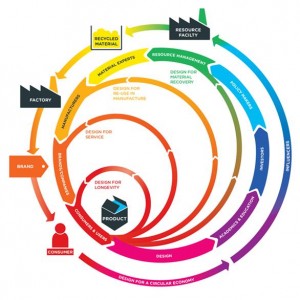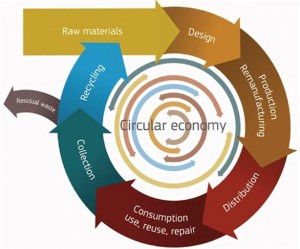A new operating system
It is not only countries like the Netherlands that take Circular Economy very serious. It is a new operating system for the world and power-blocks like Europe have made it a central item in their strategy. Maybe Europe moves slowly but the EU will create a policy framework that will impact the full value-chain from producer to consumer to waste manager and as such circular economy will become a reality. It is better to anticipate this movement and grab the many opportunities.
Let’s have a closer look at the EU’s communication on the Circular Economy. It is illustrative for the developments today.
Circular Economy
Connecting, creating and conserving value
Corporate author(s): European Commission, Directorate-General for the Environment
The circular economy concept is a response to the aspiration for sustainable growth in the context of the growing pressure of production and consumption on the world’s resources and environment. Until now, the economy has mainly operated on a ‘take-make-dispose’ model – a linear model where every product is bound to reach its ‘end of life’. Valuable materials are used to produce food, build infrastructure and homes, make consumer goods or provide energy. When these products are worn out or no longer needed, they are discarded as waste. However,
growing populations and increasing wealth make the demand for scarce resources greater than ever and lead to environmental degradation. Metals and minerals, fossil fuels, feed and food, as well as clean water and fertile land have all become more expensive. Every year in the EU, nearly 15 tonnes of materials
are used per person, while each EU citizen generates, on average, more than 4.5 tonnes of waste annually, almost half of which is disposed of in landfill sites. The linear economy, which relies exclusively on resource extraction, is no longer a viable option (1). A transition to a circular economy shifts the focus to
reusing, repairing, refurbishing and recycling existing materials and products. What used to be regarded as ‘waste’ can be turned into a resource. The circular economy is best understood by looking into natural, living systems that function optimally because each of their components fits into the whole. Products are intentionally designed to fi t into material cycles, and as a result materials flow in a way that keeps the value added for as long as possible – and residual waste is close to zero. Switching to a circular economy needs the involvement and commitment of many different groups of people. Policy-makers’ role is to provide the framework conditions, predictability and confidence to businesses, enhance the role of consumers, and set out how citizens can secure the benefits of the changes under way. Business can redesign complete supply chains for resource efficiency and circularity. Such a systemic transition is helped
by ICT developments and social change. The circular economy may thus create new markets responding to shifts in consumption patterns away from traditional ownership towards using, reusing and sharing products, and contribute to more and better employment.
Europe has already prepared the ground for this transition: a Resource Efficient Europe is one of the Europe 2020 flagship initiatives that coordinates actions across many policy areas to secure sustainable growth and jobs through better use of resources (2)
Design for a circular economy
Business is in the driver’s seat in the transition to a circular economy. Short product lifetimes has been a key approach for many companies in the past, promoting frequent upgrades and ‘must have’ latest technologies. Now, business can grasp
opportunities to extend product lifetimes and create competitive products that will last. Design for circularity is the starting point in the development of any new product or service
in the circular economy. Cars, computers, household appliances, packaging and many other products can be designed with
durability, reuse, repair, remanufacturing and recycling in mind. Greater cooperation within and across supply chains can cut costs,
waste and environmental harm. Advances in eco-innovation
provide new products, processes, technologies and organizational
structure. Some companies will find new markets by moving away from selling products towards selling services, and develop business models based on leasing, sharing, repairing, upgrading or recycling individual components. Many business opportunities for SMEs will emerge from this new approach. The European Resource Efficiency Platform (EREP) has identified a number of promising areas for business to pursue (3), such as improving information on what resources a product contains and how it can be repaired or recycled, new business models, and principles for sustainable sourcing standards. Moreover, new financial and accounting frameworks are needed to encourage resource efficiency and circularity rather than wasteful consumption. And
to help institutional investors invest more in the circular economy, the potential of the bond market should be explored, including for small projects and SMEs.
Sustainable consumer choices
Making sustainable choices should become easier – more accessible, attractive and affordable –for all consumers. Their decisions are affected by a range of factors, including the behaviour of other people, the way they receive information or advice, or the immediate costs and benefits of their choices. People’s behavior can also be influenced by changes at their workplace or in the infrastructure around them, such as facilitating cycling over car use, and by marketing sustainable
lifestyles. Such factors can help make a critical transition in thinking – from ‘consumer’ to ‘user’ or from ‘owner’ to ‘sharer’, and create more demand for services linked to renting, sharing,
swapping, repairing and remanufacturing products. Policy in support of the transition Stimulating the circular economy requires extensive policy support at European, national, regional and local levels. As supply chains spread globally, the international policy dimension is also crucial. Moving to a circular economy is an essential element of the vision that the EU and its Member States defined in the 7th Environment Action Programme (4): “Our prosperity and healthy environment stem from an innovative, circular economy where nothing is wasted and where natural resources are managed sustainably, and biodiversity is protected, valued and restored in ways that enhance our society’s resilience.” The EU has already taken steps in that direction. A waste hierarchy has been established, giving priority to reducing and recycling waste. Chemicals policy aims at phasing out toxic substances of very high concern. Projects related to the circular economy are supported by European funds. Green Public Procurement initiatives by public authorities stimulate demand for greener products and services and encourage similar choices by business. Likewise, the Eco-design Directive for energy-related products – such as kitchen equipment and double glazing – helps companies develop innovative products with lower environmental impacts. The Commission will work towards an enabling framework for the circular economy, which combines regulation, market-based instruments, research and innovation, incentives, information exchange, and support for voluntary approaches in key areas. To bring these elements together and link them to the resource efficiency agenda, EREP called on the EU to set a target securing an increase in resource productivity by well over 30 % by 2030.
Broad participation – from niche to mainstream
The rapid uptake of the opportunities – and dealing with the challenges – of the circular economy depends on broad support from society. Involving NGOs, business and consumer
organisations, trade unions, academia, research institutions and other stakeholders is essential at all levels of governance. They can act as enablers, leaders and multipliers in the shift to a circular economy. Action is also needed to communicate the ideas and benefits of the circular economy to people in their everyday lives – at the workplace, in schools and among local communities. Social networks and media powered by ICT can mobilise numerous consumers around new circular products and services.
Challenges
A growing number of policies and initiatives now support this transition towards the circular economy. However, specific political, social, economic and technological barriers to wider implementation and take-up still persist:
• companies often lack awareness, knowledge or capacity to pursue circular economy solutions;
• current systems, infrastructure, business models and technology can lock the economy in a linear model;
• investment in measures to improve efficiency, or innovative business models, remains insufficient as they are perceived as risky and complex;
• demand for sustainable products and services may remain low, in particular if they involve behavioral change;
• prices often do not reflect the real cost to society of resource and energy use;
• policy signals for the transition to a circular economy are not sufficiently strong and consistent.
Opportunities
Measures such as better eco-design and waste prevention
and reuse can bring net savings EU-wide to businesses
of up to EUR 604 billion or 8 % of their annual turnover,
while reducing total annual greenhouse gas emissions
by 2-4 %5 . Overall, implementing additional measures to
increase resource productivity by 30 % by 2030 could boost GDP by nearly 1 %, while creating over 2 million more jobs than in a business-as-usual scenario (6). European citizens are convinced of a strong positive link between growth, jobs and resource efficiency. A recent Eurobarometer (7) revealed that a substantial majority of people think that the impact of more efficient resource use would have a positive effect on the quality of life in their country (86 %), on economic growth (80 %), as well as on employment opportunities (78 %). Moreover, they
see reducing and recycling waste both at home (51 %) and in industry and construction (50 %) as the way to make the biggest difference in how efficiently resources are used.
(1) http://epp.eurostat.ec.europa.eu/portal/page/portal/environment/introduction
(2) http://ec.europa.eu/resource-effi cient-europe/
(3) http://ec.europa.eu/environment/resource_effi ciency/re_platform/index_en.htm
(4) http://ec.europa.eu/environment/newprg/index.htm
(5) ‘The opportunities to business of improving resource effi ciency’ (2013), AMEC et al.
(6) ‘Modelling the economic and environmental impacts of change in raw material consumption’ (2014), Cambridge Econometrics et al.
(7) Flash Eurobarometer 388: ‘Attitudes of Europeans towards waste management and resource effi ciency’


